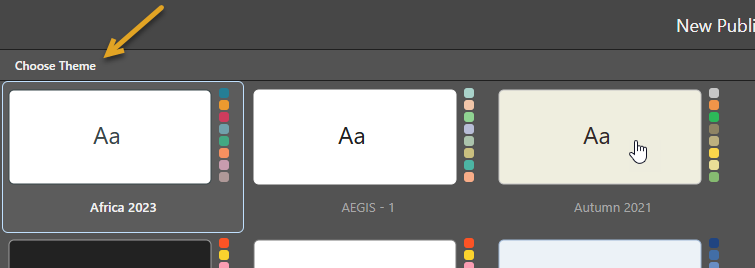Themes control the visual aspects of your publication, setting the fonts, colors, layout, and default styling to be used throughout your publication's pages. Using a theme ensures that your publication has a consistent style, fitting in with your corporate or other branding, and making sure that all Grids, Visuals, Slicers, and Text Fields have a shared, professional appearance.
Themes are also linked to Masters. Masters are template pages that contain the titles, images, headers, footers, and so on that should be included either on every page of your publication (the content master) or just on the cover page of your publication.
Note: Some themes are supplied out-of-the-box by Pyramid. If you are an administrator, you can create or edit your own themes (including applying your own masters) using the Admin Console.
Setting a theme for your publication
You set the theme for your publication either when you are creating a new publication or when you are editing an existing publication's design settings.
Choosing a theme on create
When you create a new publication, you are prompted to choose a theme:

- Click here for more information about building a publication
Changing to a different theme
Once you have created your publication, you can change the theme it uses at any time. The newly chosen theme affects the appearance of the whole publication, including the fonts, colors, styles, cover and content masters, the appearance of the "one-off" visuals in your publication, and so on. Selecting a new theme does not change the appearance of visuals that are "shareable" (that is, visuals that are saved for re-use in the content manager), nor does it automatically override any customizations you have made to your text or page backgrounds.
From the Design ribbon:
- Select a new theme:
- Use the up and down arrows (green highlight) to scroll through the available themes.
- Use the drop-down (purple arrow) to expand the themes panel so that you can see all of the available themes in one view.
- Click the snapshot (blue arrow) to select and apply a theme to your publication. Note that the snapshot background indicates the default background color for your publication's pages, and the row of color "swatches" shows the color palette used in the theme.
- Select one of the following master override options:
- Yes, replace: To replace the current masters with new masters, and thereby change the covers, headers and footers, and so on.
- Yes, delete: To stop using the current masters. Warning: Selecting this option means your publication loses all its old master-driven appearance settings.
- No, keep existing: To keep the current masters. You should select this option if you want to change your theme (colors, fonts, and so on), but you don't want to change your masters (you want to keep your cover page, headers and footers, and so on).

The Confirm Overrides dialog opens. This dialog indicates whether your new theme is associated with a set of master pages ("pre-defined master pages") and allows you to choose whether to override your existing master settings or not.
The theme is changed. This action may take a short while to complete.
Impact on existing content items
If there are already content items on your canvas when you change your theme, or if you add existing content items from the content management system, they may not be impacted by the new theme.
Visuals
Whether visuals are updated by the new theme depends on the visual itself:
- For one-off visuals that only exist in this publication, the new theme overrides the existing theme. This happens even if the visual was previously customized to use a different theme from the rest of the publication.
- For shareable visuals that are saved to the content management system, the visual has its own theme and is not affected by the publication's change of theme.
Tip: You can select a custom theme for a visual either when you edit it in Discover (right-click Open in Discover) or when it is created using Discover Lite or Smart Reporting.
Shapes
Any shapes that were added to the publication before the theme was changed are unaffected by the change of theme. They retain the same stroke and fill that they were either created with or that the user customized using the options in the ribbon.
Text
If your text uses a style (Heading 1, for example), the text is updated to use the equivalent style from the new theme. Any static text that has not been customized is also updated to match the new theme.
Any text where a formatting override is applied; for example, where the text has a custom color or is bold; retains that override when the theme is applied.
Page background
Any pages where the background color is customized using the option on the overhead ribbon are not affected by a change of theme.
Resetting format customizations
If you want to revert your customizations on a page:
- Click Reset Formatting from the Design ribbon (orange arrow above).
Customizing your masters
Each theme contains masters that drive the design of your cover and content pages; for example, they define what should be included on the header and footer of every page of your publication, or where your corporate logo should be. When you select a theme, any master pages associated with that theme are enabled.
- Click here for more information about master pages